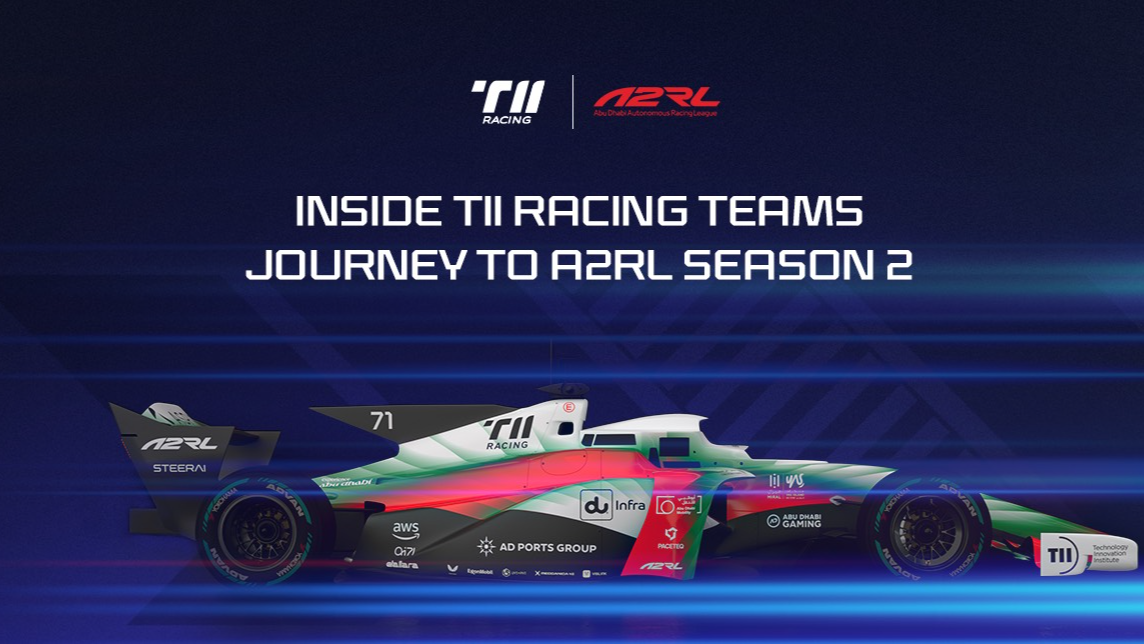When the lights go out at Yas Marina Circuit on November 15, it won’t just mark the start of another race, it will signal the return of the Abu Dhabi Autonomous Racing League (A2RL), where 11 teams blend robotics, artificial intelligence (AI) and racing strategy to compete on track. Among them is TII Racing, the Technology Innovation Institute’s autonomous motorsport team, back for its second season with sharper algorithms and fresh insights.
With the spotlight often on the machines, this blog is a look at the people behind the car - the engineers whose ideas, experiments, and long hours have helped shape TII Racing’s 2025 contender.
A Race Like No Other
At A2RL’s inaugural race in 2024, Instituto Superior Técnico - Universidade de Lisboa, Robotics Engineer at TII’s Autonomous Robotics Research Center, watched something few engineers ever get to see: an autonomous racecar he had helped program running side by side with a former Formula 1 driver and doing it entirely on its own.
“It was our first public demo,” recalls Simões, a robotics engineer focused on autonomous algorithms. “We opened the race by running alongside Daniil Kvyat. Seeing our autonomous car perform on track, in front of a live audience, was an incredible milestone for everyone on the team.”
A2RL is a race unlike any other. Every team uses the same Super Formula chassis, fitted with identical sensors, cameras, and onboard computers. The difference lies entirely in the software, the virtual driver each team has developed. Where traditional racing is a contest of skill and instinct, A2RL tests perception algorithms, path-planning logic, and decision-making under pressure.
“It’s a constant loop of testing, analyzing, and trying to improve,” says Simões. “Even after race day, we’re still learning from every lap.”
That loop defines the rhythm inside TII Racing. For most of the year, engineers work in simulation, running thousands of virtual laps to test new ideas before taking them to the track. “If there are no test days, most of my time is spent developing new features or refining existing ones through simulation,” Simões explains. “When we’re at the track, the focus shifts to reviewing data, identifying issues, and fine-tuning the software stack between sessions to extract the best performance possible.”
A Team Focused on Pushing the Limits
For Michael Baumgartner, a technical lead who oversees the technical direction of the team, the job is as much about coordination as coding. “It’s a constant challenge switching between organization and solving technical challenges,” he says. “I’m the interface to the competition and to management for the team.”
His task is to ensure every part of the system, from perception and planning to control and communications, works together seamlessly. “From a technical standpoint, the ever-changing conditions, tires, road, temperature, and the fast reactions to the decisions of opponents are a real challenge.”
This year, Simões’ main focus was on the online speed-planning system, which determines how fast the car can safely travel through each section of the circuit based on grip, temperature and strategy. “The system has to be both intelligent and precise under extreme conditions,” he says.
Progress comes incrementally: cleaner lines through complex sections, more consistent lap times, fewer adjustments between runs. With identical hardware across the grid, any difference in performance reflects the intelligence of the software, and the teamwork behind it.
“As a racing team, everyone is driven, always pushing for faster, higher, better.” Baumgartner says. “This really motivates you every day and brings out the best in you.” Simões agrees: “The team culture at TII Racing is highly collaborative and fast-paced, but also very technical. There’s a strong sense of ownership, and despite the pressure of competition, the atmosphere remains supportive and focused on continuous improvement.”
Engineering the Future
Both engineers came to TII Racing through university driverless programs, where they first discovered the connection between robotics and motorsport. Baumgartner, a mechanical engineer specializing in automotive systems at the Technical University of Munich, led the integration between autonomous and conventional racecars before moving into professional research. Simões, who studied robotics, joined his university’s driverless Formula Student team to apply his coursework to real-world challenges.
Autonomous racing unites the precision of robotics with the spirit of motorsport, Baumgartner explains, adding that being able to see immediately whether something works is highly satisfying.
For Simões too, that immediacy is what makes the discipline so compelling. “What makes autonomous racing such an exciting challenge,” he says, “is the combination of two different areas: autonomous systems and high-performance motorsport. A small mistake in judgment or control can lead to a crash, so the system has to calculate the fine line between control and chaos, intelligence that performs flawlessly at 250 km/h.”
As A2RL grows, so does the body of knowledge it produces. Each season provides new data, sharper algorithms, and greater confidence that autonomous systems can make complex decisions in real-time, safely, and reliably.
Beyond the racetrack, insights from A2RL feed directly into broader research on autonomous navigation, safety systems, and decision-making under uncertainty, all critical to the UAE’s growing AI ecosystem.
For TII Racing, the value lies as much in the process as the results. Every lap is another experiment, another step in proving that autonomy performs best when it’s tested under pressure and in public view.
From that first run alongside a professional driver to this year’s grand final, TII Racing’s journey has been one of constant refinement, not just of software, but of teamwork.
The race may last minutes, but the learning continues long after the checkered flag.


